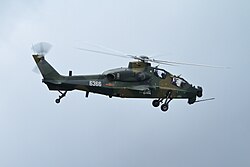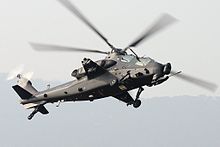WZ-10
| WZ-10 | |
|---|---|

|
|
| Type: | Attack helicopter |
| Design country: | |
| Manufacturer: | |
| First flight: |
April 29, 2003 |
| Commissioning: |
Early 2011 |
WZ-10 (WZ for Wuzhuang Zhisheng ) is the first attack helicopter developed in China . It is referred to as a violent lightning bolt, in Chinese Pi Li Huo , and is primarily used as an anti-tank helicopter.
development
The Chinese army aviators saw a loophole in combating large armored formations. Since they were denied the purchase of the Mi-24 and AH-1 Cobra , eight French gazelles were tried. Harbin Z-9s were also equipped with anti-tank guided missiles to bridge the gap . As the Chinese aviation industry only had experience in the licensed construction of civil multi-purpose helicopters, the Russian helicopter manufacturer Kamow was commissioned to design the WZ-10 thanks to its many years of experience. Under lock and key, Kamow developed Project 941 in accordance with the Chinese framework in the 1990s. The attack helicopter designed in this way was designed with models in the wind tunnel. The concept called for, among other things, the integration of anti-tank guided missiles, FLIR sensors and a pivoting bow automatic cannon. After completion of the conception phase, the 602nd Chinese Development Institute, with the help of Harbin and CAIC, continued to develop the project in strict secrecy without Russian help. It has modern avionics ( fly-by-wire , IR sensors, laser rangefinder, MIL-STD-1553 B data bus), a five-bladed main rotor and a four-bladed x-shaped tail rotor. The first flight is said to have taken place on April 29, 2003. The prototypes were still equipped with Pratt & Whitney PT6C-76C engines, each with an output of 1268 kW, which, however, were not used for the production version after protests in the USA. Due to the weaker series engines, a redesign in the direction of reducing the empty weight was necessary. At the beginning of 2011, the Chinese Army Aviation Troops put a first regiment into service with the 5th Army Aviation Regiment in Nanjing with around eight of the now known as Z-10A helicopters.
User countries
![]() People's Republic of China - Chinese Army
People's Republic of China - Chinese Army
- 60 × WZ-10 (incoming)
Technical specifications
| Parameter | Data |
|---|---|
| length | 14.2 m |
| width | 4.3 m |
| height | 3.85 m |
| Empty mass | 5544 kg |
| Max. Takeoff mass | 7200 kg |
| drive | two WZ-9 turbines with 957 kW each (Chinese version of a Pratt & Whitney engine) |
Armament
- Pivoting installed barrel armament in the turret under the nose
- 1 × unknown 23 mm automatic cannon
- 1 × Chinese version of the 25mm M242 Bushmaster automatic cannon
- 1 × Chinese version of the Shipunov 2A42 30mm automatic cannon
- Armament at four external load stations under the two stub wings
- Air-to-air guided missile
- 2 × double guided missile launchers for 2 × CAIC TY-90 each
- 2 × guided missile suspensions for 4 × HJ-10 each
- 2 × guided missile suspensions for 4 × Norinco Hong Jian-9 (HJ-9) each - laser-controlled
- 2 × guided missile suspensions for 4 × HJ-8 each
- Unguided air-to-surface missiles
- 4 × missile tube launchers with unguided HJ-73 air-to-surface missiles; Caliber 57 mm
Web links
Individual evidence
- ↑ Chinese WZ-10 attack helicopter based on Kamov design - www.flightglobal.com, March 2013
- ↑ FliegerRevue, March 2011, p. 25, The Z-10 shows contours
- ↑ FliegerRevue February 2011, p. 8, China's attack helicopter in service
